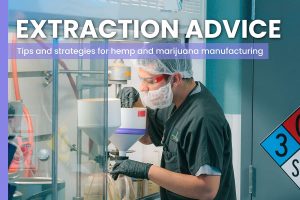
(This is the seventh installment in an ongoing series offering tips and advice for marijuana and hemp extraction companies. The sixth installment is available here.)
Three words that can wreck a cannabis manufacturer’s day, week, month, maybe even year: mold and microbials.
Extracted hemp and marijuana products that have been improperly handled and stored are susceptible to a host of contaminants that can ruin the whole batch.
Tips to lessen the chance of mold and microbials damaging material include:
- Using steps in the solvent-based process to help remove contaminants.
- Keeping moisture out at all stages.
- Storing the finished product in air-tight containers.
- Properly testing and storing the raw material before extraction.
Unwanted microorganisms not only degrade the material but also secrete toxins, according to Andras Gaspar, chief product officer for RotaChrom Technologies, a chromatography technology company based in Budapest, Hungary, that works with the international hemp market.
“Such exposed material is condemned for disposal and even considered as hazardous waste,” Gaspar wrote in an email to Hemp Industry Daily.
“To be able to remediate a polluted extract, one needs to consider not only the toxins and other potential hazardous metabolites, but also the microbe itself that needs to be removed from the material.”
‘Kill steps’
The solvent-based extraction process has a number of stages that can help to remove contamination from the material.
Quinn Shiskin, director of products and innovation at The Valens Co., a cannabis product manufacturer based in Kelowna, British Columbia, calls them “kill steps.”
The first is to use radiation to remove contaminants from the raw material before it goes to processing.
Shiskin recommends finding a third-party vendor for this step. There are many companies out there that also do this for the food industry.
According to Shiskin, radiation does not degrade THC, CBD or terpene content.
The next step depends on the type of solvent used in the extraction process. Ethanol, for example, will help to remove any mold or microbials.
Winterization is another kill step. At Valens, the extracted product is chilled at temperatures as low as -80 degrees Celsius for 24-48 hours.
To create distillate from the crude oil, the material goes through another process that superheats the oil. “That would help to ensure clean resin is achieved,” Shiskin said.
Moisture is the enemy
For Craig Henderson, CEO of Extract Labs, a hemp-derived CBD producer in Boulder, Colorado, preventing mold and microbials in his products is as simple as removing any excess water.
“I’ve seen people pull crude extract out of the machine with water in it,” he said.
That’s a surefire way to develop mold and mildew.
Henderson’s operation uses hydrocarbon and CO2 as its solvents for extraction. Crude oil gets baked at temperatures high enough to kill contaminates.
The winterization process also uses alcohol to remove fats and lipids from the oil.
If there’s any extra moisture left, the rotary evaporator removes it.
Henderson’s team uses isopropyl alcohol to clean all surfaces and separates the packaging and labeling zones from the manufacturing units.
On the question of storage, Henderson stores the extracted product in sealed glass jars out of direct exposure to sunlight in a temperature-controlled environment.
Shiskin keeps product in stainless steel containers with air-tight silicon lids.
Good inputs, good outputs
Another tip: Keep plant material, which is inherently wet, stored away from the manufacturing area.
Some claim it’s possible to still make good, concentrated marijuana with moldy plant material because the extraction process removes the impurities.
But most would rather not.
Shiskin recommends analyzing the input biomass – hemp or marijuana – before the extraction process.
He takes from the top, middle and bottom of the plants to achieve a uniform, representative sample and puts it through rigorous analytical testing for total yeast and mold counts as well as a variety of other contaminants.
Dan Ramsey, CEO of Natural Supply – which provides cultivation and extraction supplies to the marijuana and hemp industry from Grand Junction, Colorado – agrees that proper storage of the raw material is key to preventing problems in the extraction process.
The containers, whether they’re glass or plastic totes, should be the right size to allow all the plant material to get air. Cannabis in the center of large containers often doesn’t get enough airflow.
Ramsey also suggests using desiccant packs that help maintain a consistent 62% to 65% relative humidity.
For marijuana, Ramsey also likes using patented ExHale bags, which are specifically designed to let moisture out. Larger amounts of hemp can be stored in breathable tote bags.
He recommends storing raw cannabis in clean, temperature-controlled rooms with good ventilation and dehumidification and away from sunlight.
“That’s where environment’s more important. Colorado’s pretty dry,” Ramsey said. “In other areas, you might want to have a more controlled environment for exhalation or dehumidification.”
Bart Schaneman can be reached at [email protected].

